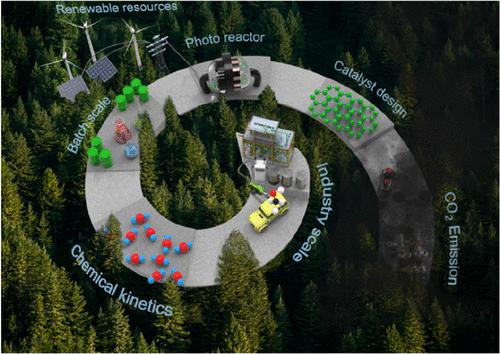当前位置:
X-MOL 学术
›
Energy Fuels
›
论文详情
Our official English website, www.x-mol.net, welcomes your feedback! (Note: you will need to create a separate account there.)
Photocatalytic Reduction of Carbon Dioxide to Methanol: Carbonaceous Materials, Kinetics, Industrial Feasibility, and Future Directions
Energy & Fuels ( IF 5.2 ) Pub Date : 2023-05-16 , DOI: 10.1021/acs.energyfuels.3c00714 Parameswaram Ganji 1 , Ramesh Kumar Chowdari 1 , Blaž Likozar 1
Energy & Fuels ( IF 5.2 ) Pub Date : 2023-05-16 , DOI: 10.1021/acs.energyfuels.3c00714 Parameswaram Ganji 1 , Ramesh Kumar Chowdari 1 , Blaž Likozar 1
Affiliation

|
Photocatalytic carbon dioxide reduction (PCCR) for methanol synthesis (CH3OH) targeting renewable energy resources is an attractive way to create a sustainable environment and also balance the carbon-neutral series. The application of PCCR to methanol enables the generation of solar energy while reducing CO2, killing two birds with one stone in terms of energy and the environment. In recent years, research on CO2 utilization has focused on hydrogenation of CO2 to methanol due to global warming. This article mainly focuses on selective carbonaceous materials such as graphene, mesoporous carbon, and carbon nanotubes (CNTs) as catalysts for heterogeneous photocatalytic CO2 reduction to methanol. In addition, special emphasis will be placed on the state of the art of PCCR catalysts as this type of research will be of great benefit for further development in this field. The main features of the reaction kinetics, techno-economic study, and current technological developments in PCCR are covered in detail.
中文翻译:

二氧化碳光催化还原成甲醇:碳质材料、动力学、工业可行性和未来方向
以可再生能源为目标的用于甲醇合成 (CH 3 OH)的光催化二氧化碳还原 (PCCR)是创造可持续环境并平衡碳中性系列的有吸引力的方式。将PCCR应用于甲醇,既可以产生太阳能,又可以减少CO 2,在能源和环境方面一举两得。近年来,由于全球变暖, CO 2的利用研究集中于CO 2加氢制甲醇。本文主要关注选择性碳质材料,如石墨烯、介孔碳和碳纳米管 (CNT) 作为多相光催化 CO 2的催化剂还原为甲醇。此外,将特别强调 PCCR 催化剂的最新技术水平,因为此类研究将对该领域的进一步发展大有裨益。详细介绍了反应动力学的主要特征、技术经济研究和 PCCR 的当前技术发展。
更新日期:2023-05-16
中文翻译:

二氧化碳光催化还原成甲醇:碳质材料、动力学、工业可行性和未来方向
以可再生能源为目标的用于甲醇合成 (CH 3 OH)的光催化二氧化碳还原 (PCCR)是创造可持续环境并平衡碳中性系列的有吸引力的方式。将PCCR应用于甲醇,既可以产生太阳能,又可以减少CO 2,在能源和环境方面一举两得。近年来,由于全球变暖, CO 2的利用研究集中于CO 2加氢制甲醇。本文主要关注选择性碳质材料,如石墨烯、介孔碳和碳纳米管 (CNT) 作为多相光催化 CO 2的催化剂还原为甲醇。此外,将特别强调 PCCR 催化剂的最新技术水平,因为此类研究将对该领域的进一步发展大有裨益。详细介绍了反应动力学的主要特征、技术经济研究和 PCCR 的当前技术发展。







































 京公网安备 11010802027423号
京公网安备 11010802027423号